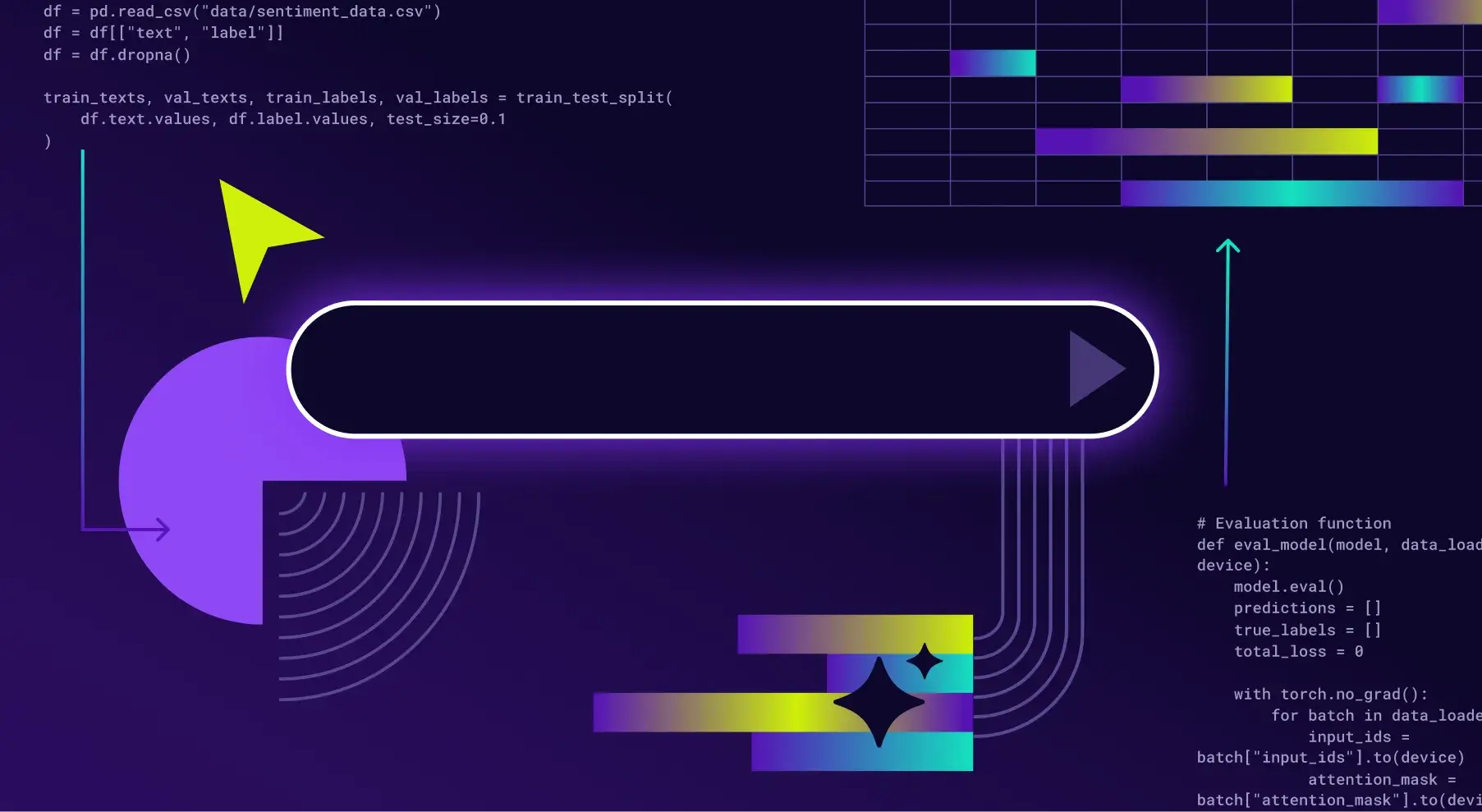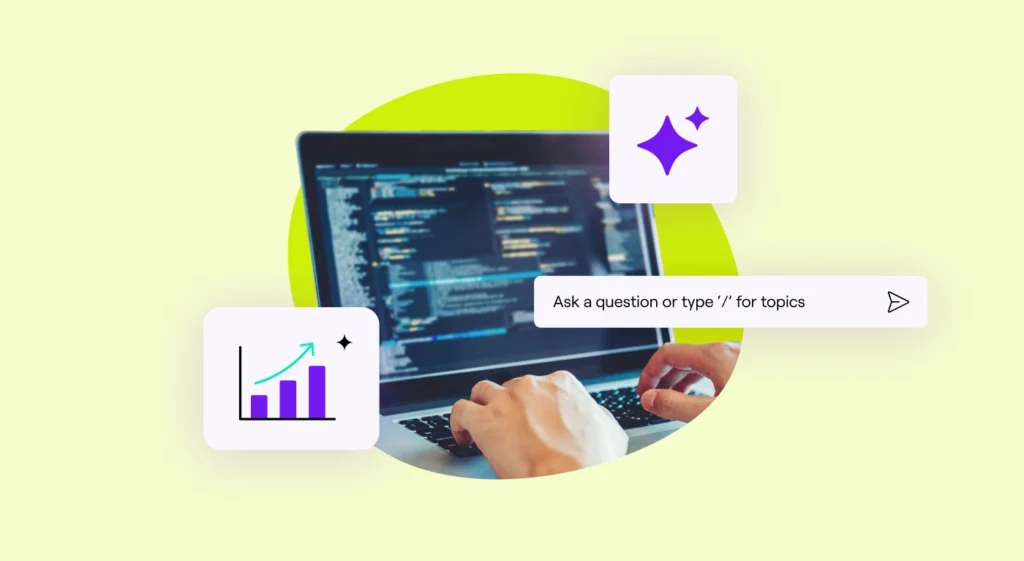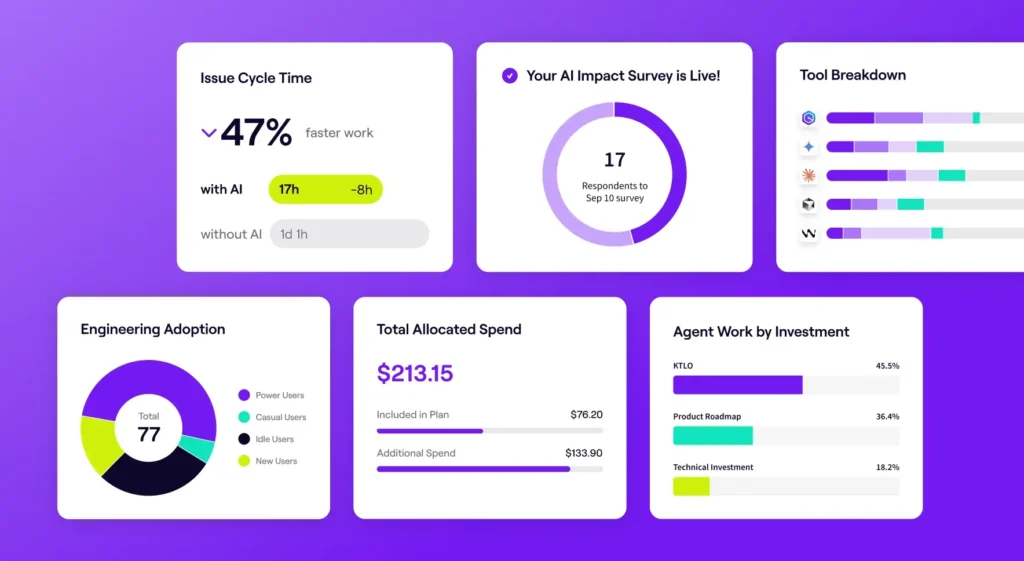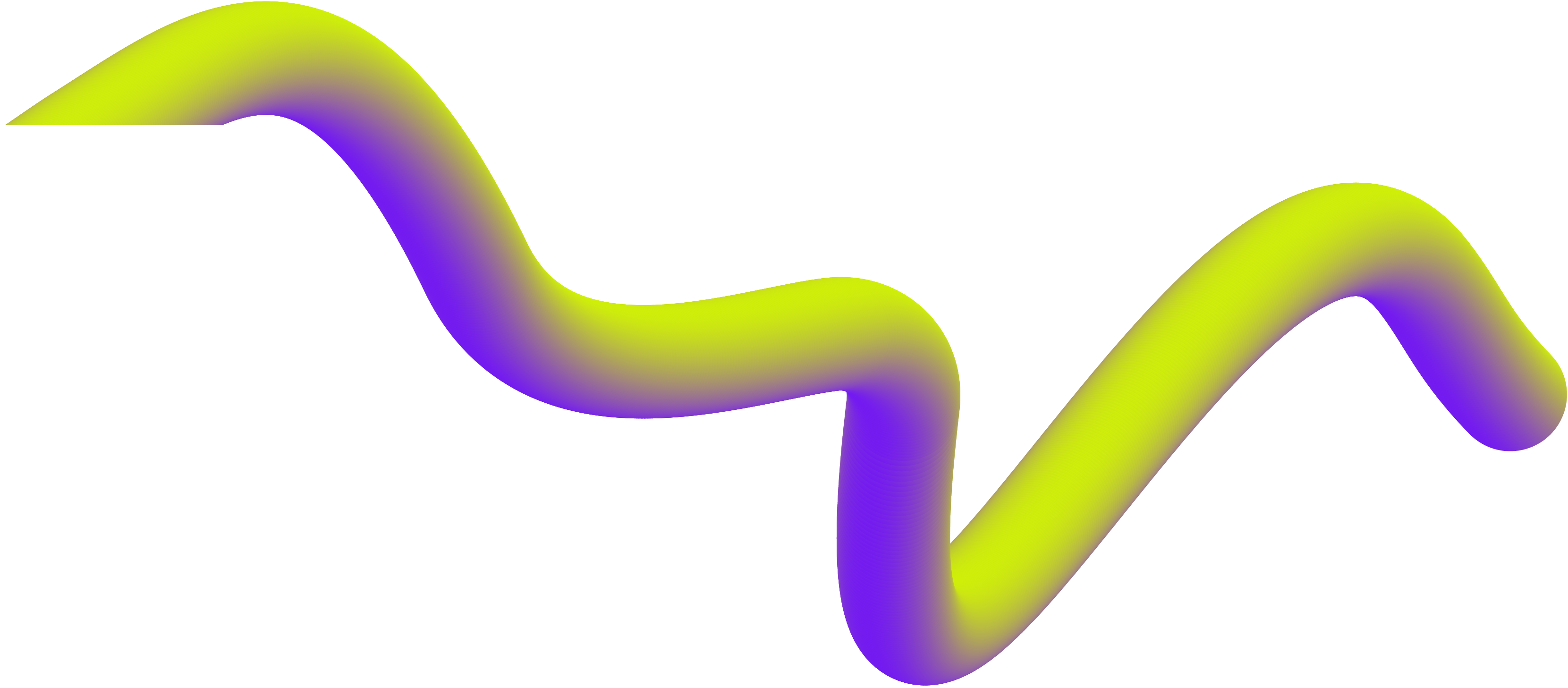As AI coding tools continue to reshape the role of engineers and the impact they drive throughout R&D organizations and businesses overall, Jellyfish is taking a closer look at the actual use and impact of AI.
The following analysis of over 2 million PRs, from July 2024 to June 2025, is based on AI use in real-world engineering environments pulled from our AI Impact solution.
What we’re seeing is astonishing. Our data shows that it’s getting easier to use AI as barriers to entry continue to fall. That’s caused a surge in use, with PRs using AI increasing from just 14% in June 2024 to 51% this year.
Key Takeaways
Key Takeaways
- AI use has exploded. 51% of PRs in May 2025 use AI, compared to just 14% in June 2024.
- Average AI PR cycle times are 1.16x faster in Q2 2025, compared to 1.11x faster in Q3 2024.
- Gains are coming from both faster coding and faster reviews. In Q2 2025, average PR cycle time went from 95.5 hours to 83.8 hours (13.7 hours saved). Of this total, 8.6 hours was coding time and 5.1 hours was review time.
- We found no meaningful correlation between the number of bugs introduced and an organization’s level of AI adoption. Ranking companies by their level of AI adoption, the number of bug (vs story or task) PRs remains consistent in the 8-9% range.
- Senior engineers saw bigger gains in 2024, but junior engineers have caught up over the last 12 months. Regardless of seniority, PRs using AI are around 1.2x faster than those authored without AI as of Q2 2025.
About the Data
About the Data
This data set is pulled from Jellyfish’s AI Impact solution and covers GitHub Copilot users only from June 2024 to mid-June 2025. It covers 259 companies across 21,209 engineers with 2,160,981 merged PRs.
For PRs with 2 or more commits, we look at cycle time (time from first commit to merge), which is broken down into “coding time” (from first commit to last commit) and “review time” (from last commit to merge).
PRs are also broken down by seniority and role:
- Across 21,209 engineers*:
- Junior: 813,748 PRs (41.1%)
- Senior: 762,958 PRs (38.6%)
- Unknown: 368,996 PRs (18.7%)
- Manager: 34,072 PRs (1.7%)
*Seniority / role are parsed from roster titles.
AI Use is Accelerating
AI Use is Accelerating
AI is steadily climbing, resulting in big increases over 2024 usage levels.
- Fraction of PRs with “high AI use” was 51.5% in May 2025 compared to 40.4% in December 2024 and 14.0% in June 2024
- Ratio of “High-AI” PRs to “No-AI” PRs has grown steadily by quarter:
- 0.5-to-1 in Q3 2024
- 1.6-to-1 in Q2 2025

AI Continues to Speed Up Cycle Times
AI Continues to Speed Up Cycle Times
PR cycle times are speeding up, with big increases over 2024 levels.
- We compared the cycle times of PRs with high AI assistance to those without AI use
- PRs are tagged with the author’s level of AI use:
- None
- Low (engineer uses AI one to two times a week)
- High (engineer uses AI three or more times a week)
- Average PR cycle times for high AI tasks were 16% faster in Q2 2025 than tasks that did not use AI
- In Q3 2024, PR cycle times for high AI tasks were only 11% faster than tasks that did not use AI
- PRs are tagged with the author’s level of AI use:

Gains are coming from both faster coding and faster time to merge
- We break down cycle time into “coding time” (from first commit to last commit) and “review time” (from last commit to merge)
- Across the board, we see gains comes from both faster coding time and faster time to merge


Senior engineers have historically seen bigger gains from AI, but junior engineers have caught up
- Overall, PRs authored by senior engineers see slightly higher acceleration than those by junior engineers
- However, the gap has shrunk over time and junior engineers have caught up

From an Investment Standpoint, AI Delivers More of Everything
From an Investment Standpoint, AI Delivers More of Everything
This year, we’re not seeing the same effects between level of AI use and investment (ie. growth or roadmap work over keeping the lights on (KTLO) and support). We observed positive gains in 2024 similar to what we saw in previous (issue-based) analyses (+10% growth investment).
As late adopters come to the AI party, companies overall are getting more of everything – growth, KTLO, support – to varying degrees. In other words, the rising AI tide lifts all boats.
No Observable Difference Between Level of AI Use and Code Quality
No Observable Difference Between Level of AI Use and Code Quality
While this might have been true a year or even six months ago, we found no meaningful correlation between the number of bugs introduced and an organization’s level of AI adoption. Ranking companies by their level of AI adoption, the number of bug (vs story or task) PRs remains consistent in the 8-9% range.
Final Thoughts
Final Thoughts
AI has moved from hype to providing engineering teams with real, measurable impact. Continued investment in AI has delivered help on all fronts – speeding up cycle time, elevating junior engineers, and delivering more work across the board – all without an impact on quality.
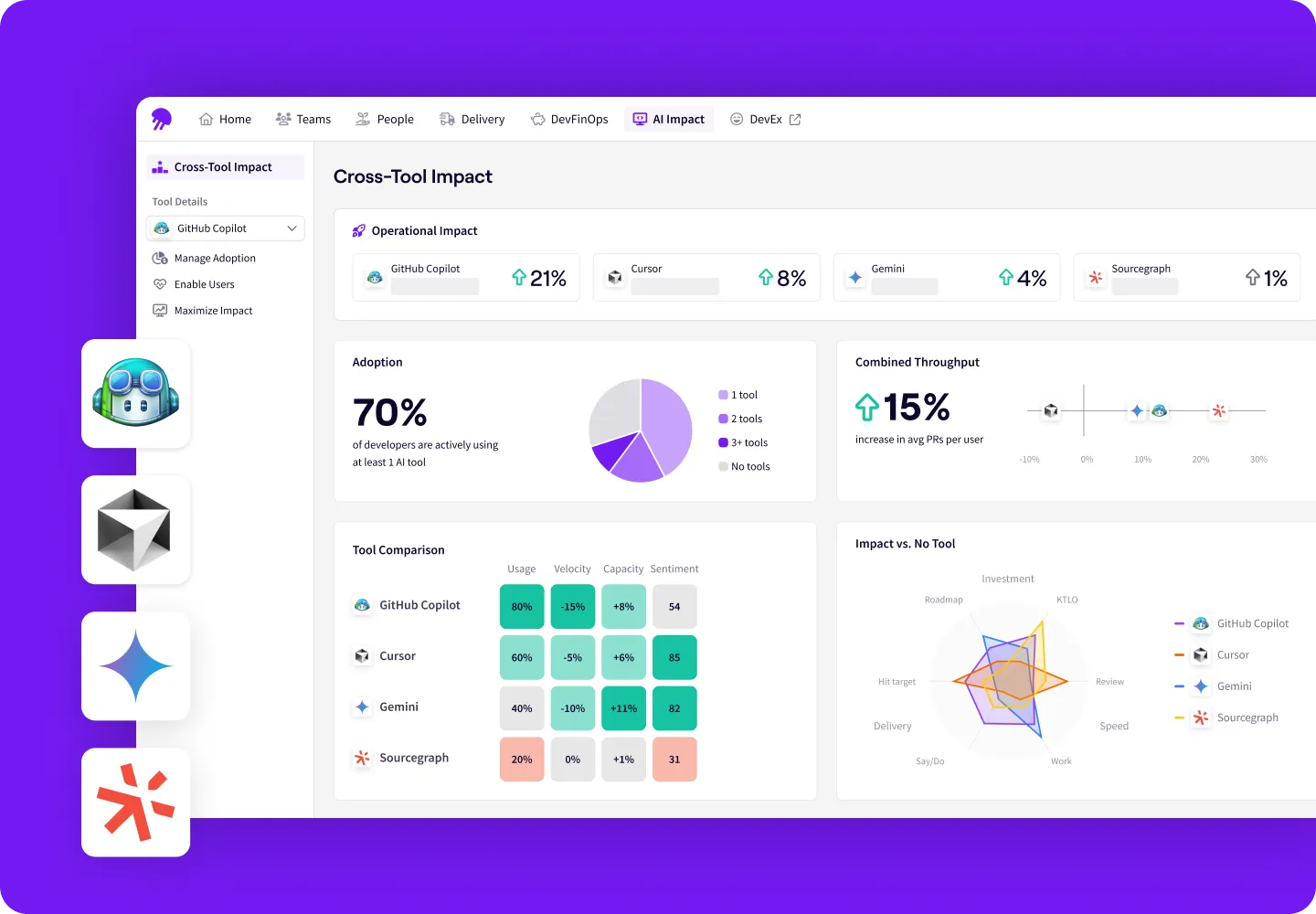
Effectively build AI-integrated engineering teams
AI tools alone won’t transform your org—Jellyfish shows you what’s working, what’s not, and how to build high-performing teams that know how to use AI the right way.
Request a DemoReport Methodology
Report Methodology
- PRs are tagged with the author’s level of AI use
- None
- Low (engineer uses AI one to two times a week)
- High (engineer uses AI three or more times a week)
- “Time” of PR refers to when the PR was merged
- Additional attributes:
- Author attributes: junior/senior, dev role
- Cycle time (first commit to merge)
- Also “coding time” (first to last commit) and “review time” (last commit to merge)
- Total commits, additions, deletions
- Linked issue attributes: type (e.g. bug), investment category
About the author

Nicholas Arcolano, Ph.D. is Head of Research at Jellyfish where he leads Jellyfish Research, a multidisciplinary department that focuses on new product concepts, advanced ML and AI algorithms, and analytics and data science support across the company.
